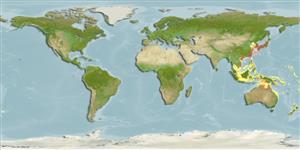Common names from other countries
Environment: milieu / climate zone / depth range / distribution range
Ökologie
seewasser demersal; ozeanodrom (Ref. 51243). Tropical
Western Pacific: southern Hokkaido, Japan to the Philippines.
Length at first maturity / Size / Gewicht / Alter
Maturity: Lm ?, range 8 - ? cm
Max length : 36.2 cm TL Männchen/unbestimmt; (Ref. 96735); max. veröff. Gewicht: 2.8 kg (Ref. 40637)
Found near shore, on rock bottom (Ref. 11230). Commercially cultured in Japan. Viviparous (Ref. 34817). Anterolateral glandular grooves with venom gland (Ref. 57406).
The species is viviparous (Ref. 5475).
Masuda, H., K. Amaoka, C. Araga, T. Uyeno and T. Yoshino, 1984. The fishes of the Japanese Archipelago. Vol. 1. Tokai University Press, Tokyo, Japan. 437 p. (text). (Ref. 559)
IUCN Rote Liste Status (Ref. 130435)
CITES (Ref. 128078)
Not Evaluated
Nutzung durch Menschen
Fischereien: kommerziell; Aquakultur: kommerziell; Sportfisch: ja
Tools
Zusatzinformationen
Download XML
Internet Quellen
Estimates based on models
Preferred temperature (Ref.
115969): 18.2 - 28, mean 26.5 (based on 274 cells).
Phylogenetic diversity index (Ref.
82804): PD
50 = 0.6250 [Uniqueness, from 0.5 = low to 2.0 = high].
Bayesian length-weight: a=0.01148 (0.00946 - 0.01393), b=3.11 (3.06 - 3.16), in cm Total Length, based on LWR estimates for this species (Ref.
93245).
Trophic level (Ref.
69278): 3.7 ±0.6 se; based on size and trophs of closest relatives
Widerstandsfähigkeit (Ref.
120179): mittel, Verdopplung der Population dauert 1,4 - 4,4 Jahre. (K=0.3).
Fishing Vulnerability (Ref.
59153): Low to moderate vulnerability (33 of 100).
